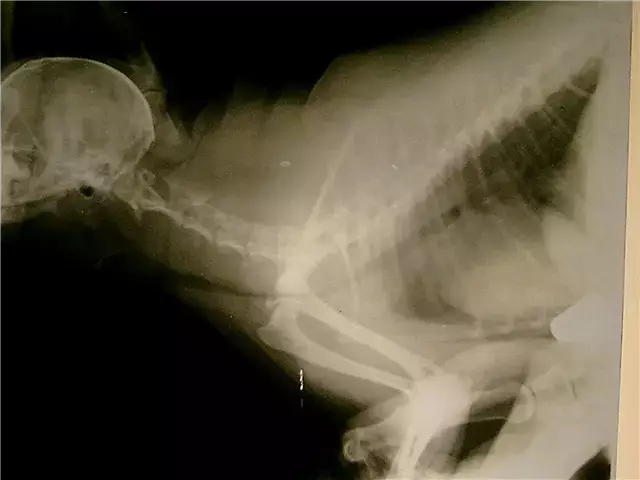- Author Rachel Wainwright [email protected].
- Public 2023-12-15 07:39.
- Last modified 2025-11-02 20:14.
Gabriglobin-IgG
Instructions for use:
- 1. Release form and composition
- 2. Indications for use
- 3. Contraindications
- 4. Method of application and dosage
- 5. Side effects
- 6. Special instructions
- 7. Drug interactions
- 8. Analogs
- 9. Terms and conditions of storage
- 10. Terms of dispensing from pharmacies
Prices in online pharmacies:
from 7139 rub.
Buy

Gabriglobin-IgG is an immunological drug.
Release form and composition
Dosage forms of Gabriglobin-IgG release:
- solution for infusion: transparent, colorless or with a yellowish tinge (in bottles of 25 or 50 ml, in a cardboard box 1 bottle);
- lyophilisate for the preparation of a solution for infusion (in bottles of 2.5 g, in a cardboard box 1 bottle complete with a solvent).
The active ingredient in 1 bottle of solution and lyophilisate: normal human immunoglobulin - 100%.
Indications for use
- bacterial / viral infections in severe course;
- primary antibody deficiency syndrome, including agamma- or hypogammaglobulinemia (period of physiological deficiency in newborns, congenital form);
- secondary antibody deficiency syndrome;
- blood diseases, the consequences of immunosuppressive therapy, acquired immunodeficiency (AIDS), especially when children are infected with the human immunodeficiency virus;
- postoperative complications with septicopyemic conditions and bacteremia.
Contraindications
Absolute:
- burdened history of allergic reactions or severe systemic reactions to human blood products;
- burdened history of anaphylactic shock to human blood products with severe sepsis;
- individual intolerance to the components of the drug, including hypersensitivity to maltose, IgA immunodeficiency.
Relative (diseases / conditions in which the appointment of Gabriglobin-IgG requires caution):
- severe heart failure;
- renal failure;
- diabetes;
- pregnancy and lactation (use is possible only on strict indications after assessing the ratio of the expected benefit with the possible risk).
Method of administration and dosage
The use of Gabriglobin-IgG is possible only in a hospital setting.
The drug is administered intravenously through the infusion system. Before the introduction, the vials with the drug must be kept for at least 2 hours at a temperature of 20 ± 2 ° C. Do not use solutions that are cloudy or contain sediment.
The dosage regimen is determined by the indications.
Usually Gabriglobin-IgG is given as follows:
- children: single dose - 3-4 ml / kg, rate of administration - from 8 to 10 drops per minute. Infusions are performed daily for 3-5 days;
- adults: a single dose - 25-50 ml, the rate of administration in the first 10-15 minutes - 15-20 drops per minute, then - 30-40 drops per minute. With more rapid management, the development of a collaptoid reaction is possible. The course is from 3 to 10 transfusions, which are carried out after 24-72 hours (depending on the severity of the disease).
Side effects
During the first days after the administration of Gabriglobin-IgG, there may be a slight increase in body temperature, as well as the development of allergic reactions.
Other possible disorders: dizziness, headache, shortness of breath, tachycardia, dyspeptic symptoms, arterial hyper- or hypotension.
With individual intolerance, in extremely rare cases, anaphylactic reactions may occur.
special instructions
Patients with autoimmune diseases (including diseases of the connective tissue, blood, nephritis) Gabriglobin-IgG should be administered against the background of appropriate therapy. Immunoglobulin passes into breast milk and can contribute to the transmission of protective antibodies to the newborn.
After the introduction of Gabriglobin-IgG, the patient's condition should be monitored for at least 30 minutes. In the room where the drug is injected, there should be anti-shock therapy agents. In cases of anaphylactoid reactions, the use of antihistamines, glucocorticosteroids and adrenomimetics is indicated.
It should be borne in mind that a short increase in the content of antibodies in the patient's blood after the administration of Gabriglobin-IgG can lead to false positive results of serological tests.
Given the likelihood of collaptoid reactions, the rate of intravenous administration cannot be exceeded.
Drug interactions
Combined use with other drugs is possible, in particular, with drugs with antibacterial action.
The introduction of Gabriglobin-IgG can weaken (for 1.5 to 3 months) the effect of live vaccines against the following viral diseases: measles, rubella, chickenpox and mumps (the recommended interval between the introduction of these drugs is 3 months).
In some cases, after the use of large doses of Gabriglobin-IgG, its effect can last up to one year.
In infants, combined use with calcium gluconate is prohibited.
Analogs
Analogs of Gabriglobin-IgG are: Intraglobin, Gabriglobin, Gamunex-S, Imbioglobulin, Intratect, Immunovenin, Octagam, Normal human immunoglobulin, Sigardis immunoglobulin, Prividzhen, Flembogama.
Terms and conditions of storage
Store in a place protected from light and moisture at a temperature of 2-10 ° C. Keep out of the reach of children.
Shelf life is 2 years.
Terms of dispensing from pharmacies
Dispensed by prescription.
Gabriglobin-IgG: prices in online pharmacies
|
Drug name Price Pharmacy |
|
Gabriglobin-IgG solution for infusion 50 ml 1 pc. RUB 7139 Buy |
Information about the drug is generalized, provided for informational purposes only and does not replace the official instructions. Self-medication is hazardous to health!






